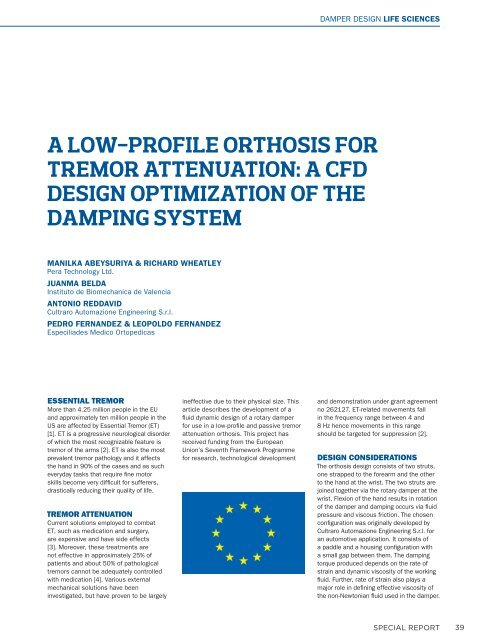Life Science Special Report December 2015
The Life Sciences Sector is experiencing an unprecedented change...
The Life Sciences Sector is experiencing an unprecedented change...
- No tags were found...
You also want an ePaper? Increase the reach of your titles
YUMPU automatically turns print PDFs into web optimized ePapers that Google loves.
DAMPER DESIGN LIFE SCIENCES<br />
A LOW-PROFILE ORTHOSIS FOR<br />
TREMOR ATTENUATION: A CFD<br />
DESIGN OPTIMIZATION OF THE<br />
DAMPING SYSTEM<br />
MANILKA ABEYSURIYA & RICHARD WHEATLEY<br />
Pera Technology Ltd.<br />
JUANMA BELDA<br />
Instituto de Biomechanica de Valencia<br />
ANTONIO REDDAVID<br />
Cultraro Automazione Engineering S.r.l.<br />
PEDRO FERNANDEZ & LEOPOLDO FERNANDEZ<br />
Especiliades Medico Ortopedicas<br />
ESSENTIAL TREMOR<br />
More than 4.25 million people in the EU<br />
and approximately ten million people in the<br />
US are affected by Essential Tremor (ET)<br />
[1]. ET is a progressive neurological disorder<br />
of which the most recognizable feature is<br />
tremor of the arms [2]. ET is also the most<br />
prevalent tremor pathology and it affects<br />
the hand in 90% of the cases and as such<br />
everyday tasks that require fine motor<br />
skills become very difficult for sufferers,<br />
drastically reducing their quality of life.<br />
TREMOR ATTENUATION<br />
Current solutions employed to combat<br />
ET, such as medication and surgery,<br />
are expensive and have side effects<br />
[3]. Moreover, these treatments are<br />
not effective in approximately 25% of<br />
patients and about 50% of pathological<br />
tremors cannot be adequately controlled<br />
with medication [4]. Various external<br />
mechanical solutions have been<br />
investigated, but have proven to be largely<br />
ineffective due to their physical size. This<br />
article describes the development of a<br />
fluid dynamic design of a rotary damper<br />
for use in a low-profile and passive tremor<br />
attenuation orthosis. This project has<br />
received funding from the European<br />
Union’s Seventh Framework Programme<br />
for research, technological development<br />
and demonstration under grant agreement<br />
no 262127. ET-related movements fall<br />
in the frequency range between 4 and<br />
8 Hz hence movements in this range<br />
should be targeted for suppression [2].<br />
DESIGN CONSIDERATIONS<br />
The orthosis design consists of two struts,<br />
one strapped to the forearm and the other<br />
to the hand at the wrist. The two struts are<br />
joined together via the rotary damper at the<br />
wrist. Flexion of the hand results in rotation<br />
of the damper and damping occurs via fluid<br />
pressure and viscous friction. The chosen<br />
configuration was originally developed by<br />
Cultraro Automazione Engineering S.r.l. for<br />
an automotive application. It consists of<br />
a paddle and a housing configuration with<br />
a small gap between them. The damping<br />
torque produced depends on the rate of<br />
strain and dynamic viscosity of the working<br />
fluid. Further, rate of strain also plays a<br />
major role in defining effective viscosity of<br />
the non-Newtonian fluid used in the damper.<br />
SPECIAL REPORT<br />
39



